Long-tailed pygmy possum
| Long-tailed pygmy possum[1] | |
|---|---|
 | |
Conservation status | |
| Scientific classification | |
| Domain: | Eukaryota |
| Kingdom: | Animalia |
| Phylum: | Chordata |
| Class: | Mammalia |
| Infraclass: | Marsupialia |
| Order: | Diprotodontia |
| Family: | Burramyidae |
| Genus: | Cercartetus |
| Species: | C. caudatus |
| Binomial name | |
| Cercartetus caudatus (A. Milne-Edwards, 1877) | |
 | |
| Long-tailed pygmy possum range | |
The long-tailed pygmy possum (Cercartetus caudatus) is a diprotodont marsupial found in the rainforests of northern Australia and New Guinea. Living at altitudes of above 1,500 m (4,900 ft), it eats insects and nectar, and may eat pollen in place of insects in the wild.
It is known as sumsum in the Kalam language of Papua New Guinea.[3]
Description
The long-tailed pygmy possum has large eyes, mouse/rodent-like ears, a pouch that opens anteriorly, and a tail that is about one and a half times as long as the body, giving the possum its name.
Behavior
Not much is known of this possum's behaviour, but what is known is that this species is both nocturnal and arboreal. In cold weather, it becomes torpid and looks and feels dead, but wakes at night. Not much is known on the origin of this torpor.
Life cycle
This species breeds twice a year. Females have one to four young born around January and February and sometimes a second litter from late August to early September. The young leave the nest when they are 45 days old.
They only grow up to 10 cm (3.9 in).
References
- ^ Groves, C. P. (2005). Wilson, D. E.; Reeder, D. M. (eds.). Mammal Species of the World: A Taxonomic and Geographic Reference (3rd ed.). Baltimore: Johns Hopkins University Press. p. 44. ISBN 0-801-88221-4. OCLC 62265494.
- ^ Aplin, K.; Dickman, C.; Salas, L.; Burnett, S.; Winter, J. (2016). "Cercartetus caudatus". IUCN Red List of Threatened Species. 2016: e.T4192A21963339. doi:10.2305/IUCN.UK.2016-2.RLTS.T4192A21963339.en. Retrieved 12 November 2021.
- ^ Pawley, Andrew and Ralph Bulmer. 2011. A Dictionary of Kalam with Ethnographic Notes. Canberra. Pacific Linguistics.
- v
- t
- e
- Kingdom Animalia
- Phylum Chordata
- Class Mammalia
- Infraclass Marsupialia
Suborder Vombatiformes | |||||||||||
|---|---|---|---|---|---|---|---|---|---|---|---|
| |||||||||||
Suborder Phalangeriformes (possums) | |||||||||||||||||||||||||||||||||||||||||||||||||||||
|---|---|---|---|---|---|---|---|---|---|---|---|---|---|---|---|---|---|---|---|---|---|---|---|---|---|---|---|---|---|---|---|---|---|---|---|---|---|---|---|---|---|---|---|---|---|---|---|---|---|---|---|---|---|
| |||||||||||||||||||||||||||||||||||||||||||||||||||||
Suborder Macropodiformes | |||||||||||||||||||||||||||||||||||||||||
|---|---|---|---|---|---|---|---|---|---|---|---|---|---|---|---|---|---|---|---|---|---|---|---|---|---|---|---|---|---|---|---|---|---|---|---|---|---|---|---|---|---|
| |||||||||||||||||||||||||||||||||||||||||












